|
Ray Carney, Shadows (BFI
Film Classics, ISBN: 0-85170-835-8),
88 pages. This book is available directly from the author
via this web site for $20.
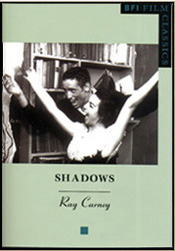
“Ray Carney is a
tireless researcher who probably knows more about the shooting of Shadows
than any other living being, including Cassavetes when he was alive,
since Carney, after all, has the added input of ten or more of the film’s
participants who remember their own unique versions of the reality we
all shared."—Maurice
McEndree, producer and editor of Shadows
“Bravo! Cassavetes
is fortunate to have such a diligent champion. I am absolutely dumbfounded
by the depth of your research into this film.... Your appendix...is
a definitive piece of scholarly detective work.... The Robert Aurthur
revelation is another bombshell and only leaves me wanting to know more....
The book movingly captures the excitement and dynamic Cassavetes discovered
in filmmaking; and the perseverance and struggle of getting it up there
on the screen."—Tom
Charity, Film
Editor, Time Out magazine
John Cassavetes’ Shadows
is generally regarded as the start of the independent feature movement
in America. Made for $40,000 with a nonprofessional cast and crew and
borrowed equipment, the film caused a sensation on its London release
in 1960.
The film traces the lives of
three siblings in an African-American family: Hugh, a struggling jazz
singer, attempting to obtain a job and hold onto his dignity; Ben, a Beat
drifter who goes from one fight and girlfriend to another; and Lelia,
who has a brief love affair with a white boy who turns on her when he
discovers her race. In a delicate, semi-comic drama of self-discovery,
the main characters are forced to explore who they are and what really
matters in their lives.
Shadows ends with the
title card "The film you have just seen was an improvisation," and
for decades was hailed as a masterpiece of spontaneity, but shortly
before Cassavetes’ death, he confessed to Ray Carney something
he had never before revealed – that much of the film was scripted. He
told him that it was shot twice and that the scenes in the second version
were written by him and Robert Alan Aurthur, a professional Hollywood
screenwriter. For Carney, it was Cassavetes‘ Rosebud. He spent
ten years tracking down the surviving members of the cast and crew, and
piecing together the true story of the making of the film.
Carney takes the reader behind
the scenes to follow every step in the making of the movie – chronicling
the hopes and dreams, the struggles and frustrations, and the ultimate
triumph of the collaboration that resulted in one of the seminal masterworks
of American independent filmmaking.
Highlights of the presentation
are more than 30 illustrations (including the only existing photographs
of the dramatic workshop Cassavetes ran in the late fifties and of the
stage on which much of Shadows was shot, and a still showing a
scene from the "lost" first version of the film); and statements by many
of the film's actors and crew members detailing previously unknown events
during its creation.
One of the most interesting and original aspects of the book is a nine-page Appendix that "reconstructs" much of the lost first version of the film for the first time. The Appendix
points out more than 100 previously unrecognized differences between the
1957 and 1959 shoots, all of which are identified in detail both by the
scene and the time at which they occur in the current print of the movie
(so that they may be easily located on videotape or DVD by anyone viewing
the film).
By comparing the two versions,
the Appendix allows the reader to eavesdrop on Cassavetes' process of
revision and watch his mind at work as he re-thought, re-shot, re-edited
his movie. None of this information, which Carney spent more than five
years compiling, has ever appeared in print before (and, as the presentation
reveals, the few studies that have attempted to deal with this issue prior
to this are proved to have been completely mistaken in their assumptions).
The comparison of the versions and the treatment of Cassavetes' revisionary
process is definitive and final, for all time.
This book is available through
University of California Press at Berkeley, Amazon,
Barnes
and Noble, and in England through Amazon
(UK) and The
British Film Institute. For a limited time, the Shadows book
is also available directly from the author (in discounted, specially autographed
editions) via this web site. See
information below on how to order this book directly from the author by
money order, check, or credit card (PayPal).
Clicking on the above links
will open a new window in your browser. You may return to this page
by closing that window or by clicking on the window for this page
again.
For reviews and critical
responses to Ray Carney's book on the making of Shadows,
please click
here.
* * *
Ray Carney, Cassavetes
on Cassavetes (Faber and Faber in London, and Farrar, Straus and Giroux
in New York), copiously illustrated, paperback, approximately 550 pages.
Available directly from the author for $25.
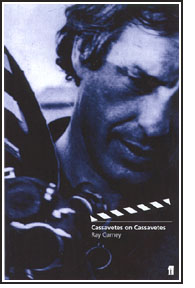 Cassavetes on
Cassavetes is the autobiography John Cassavetes never lived to write.
It tells an extraordinary saga – thirty years of film history, chronicling
the rise of the American independent movement – as it was lived by
one of its pioneers and one of the most important artists in the history
of
the medium. The struggles, the triumphs, the crazy dreams and frustrations
are all here, told in Cassavetes' own words. Cassavetes on Cassavetes
tells the day-by-day story of the making of some of the greatest and
most original works of American film. —from the "Introduction:
John Cassavetes in His Own Words"
Cassavetes on
Cassavetes is the autobiography John Cassavetes never lived to write.
It tells an extraordinary saga – thirty years of film history, chronicling
the rise of the American independent movement – as it was lived by
one of its pioneers and one of the most important artists in the history
of
the medium. The struggles, the triumphs, the crazy dreams and frustrations
are all here, told in Cassavetes' own words. Cassavetes on Cassavetes
tells the day-by-day story of the making of some of the greatest and
most original works of American film. —from the "Introduction:
John Cassavetes in His Own Words"
Click here to access a detailed description of the book and
a summary of the topics covered in it.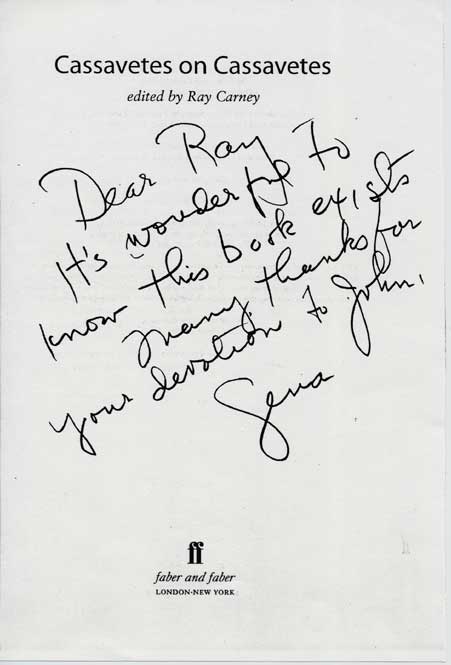
* * *
Cassavetes
on Cassavetes is available in the United States through Amazon
and Barnes
and Noble, and in England through Amazon
(UK), Faber
and Faber (UK). It is also available at your local bookseller,
or, for a limited time, directly from the author (in discounted,
specially autographed editions) for $25 via this web site.
See below for information
how to order this book directly from this web site by money order,
check, or credit card (using PayPal).
* * *
Ray Carney, The Films
of John Cassavetes: Pragmatism, Modernism, and the Movies
(New York and Cambridge: Cambridge University Press, 1994), 48 illustrations,
paperback, 322 pages. This book is available directly from the author
for $20.
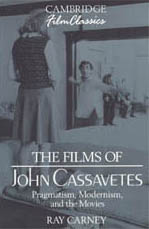
The Films of John Cassavetes tells the inside story of the making
of six of Cassavetes' most important works: Shadows, Faces,
Minnie and Moskowitz, A Woman under the Influence, The
Killing of a Chinese Bookie, and Love Streams.
With the help of almost fifty
previously unpublished photographs from the private collections of Sam
Shaw and Larry Shaw, and excerpts from interviews with the filmmaker and
many of his closest friends, the reader is taken behind the scenes to
watch the maverick independent at work: writing his scripts, rehearsing
his actors, blocking their movements, shooting his scenes, and editing
them. Through words and pictures, Cassavetes is shown to have been a deeply
thoughtful and self-aware artist and a profound commentator.
This iconoclastic, interdisciplinary
study challenges many accepted notions in film history and aesthetics.
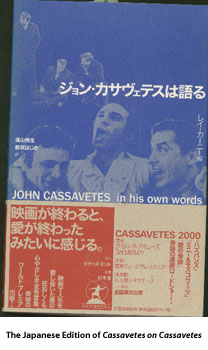 Ray Carney argues that Cassavetes' films participate in a previously unrecognized
form of pragmatic American modernism that, in its ebullient affirmation
of life, not only goes against the world-weariness and despair of many
twentieth-century works of art, but also places his works at odds with
the assumptions and methods of most contemporary film criticism. Ray Carney argues that Cassavetes' films participate in a previously unrecognized
form of pragmatic American modernism that, in its ebullient affirmation
of life, not only goes against the world-weariness and despair of many
twentieth-century works of art, but also places his works at odds with
the assumptions and methods of most contemporary film criticism.
Cassavetes' films are provocatively
linked to the philosophical writing of Ralph Waldo Emerson, William James,
and John Dewy, both as an illustration of the artistic consequences of
a pragmatic aesthetic and as an example of the challenges and rewards
of a life lived pragmatically. Cassavetes' work is shown to reveal stimulating
new ways of knowing, feeling, and being in the world.
This book is available through Amazon,
Barnes
and Noble, your local bookseller, or, for a limited time, directly
from the author (in discounted, specially autographed editions).
See below for information how
to order this book directly from the author by money order, check, or
credit card.
Clicking on the above links
will open a new window in your browser. You may return to this page by
closing that window or by clicking on the window for this page again.
* * *
For reviews and critical responses
to The Films of John Cassavetes, please click
here. (Use your back button to return.)
* * * 
Ray Carney, American
Dreaming: The Films of John Cassavetes and the American Experience (Berkeley: University of California Press, 1985). $20.
[From the original
dust jacket description:] John Cassavetes is known to millions of filmgoers
as an actor who has appeared in Rosemary’s Baby, The
Dirty Dozen, Whose Life Is It, Anyway?, Tempest,
and many other Hollywood movies. But what is less known is that Cassavetes
acts in these films chiefly in order to finance his own unique independent
productions. Over the past 25 years, working almost entirely outside
the Hollywood establishment, Cassavetes has written, directed, and
produced ten extraordinary films. They range from romantic comedies
like Shadows and Minnie and Moskowitz to powerful,
poignant domestic dramas like Faces and A Woman Under
the Influence to unclassifiable emotional extravaganzas like Husbands, The 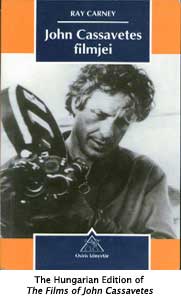 Killing
of a Chinese Bookie, and Gloria. Killing
of a Chinese Bookie, and Gloria.
This is the first
book-length study ever devoted to this controversial and iconoclastic
filmmaker. It is the argument of American Dreaming that Cassavetes
has single-handedly produced the most stunningly original and important
body of work in contemporary film. Raymond Carney examines Cassavetes’ life
and work in detail, traces his break with Hollywood, and analyzes the
cultural and bureaucratic forces that drove him to embark on his maverick
career. Cassavetes work is considered in the context of other twentieth-century
forms of traditional and avant-garde expression and is provocatively
contrasted with the better-known work of other American and European
filmmakers.
The portrait
of John Cassavetes that emerges in these pages is of an inspiringly
idealistic American dreamer attempting to beat the system and keep
alive his dream of personal freedom and individual expression – just
as the characters in the films excitingly try to keep alive their middle-class
dreams of love, freedom, and self-expression in the hostile emotional
and familial environments in which they function. His films are chronicles
of the yearnings, desires, and frustrations of the American dream.
He is America’s truest historian of the inevitable conflict between
the ideals and the realities of the American experience.
"By
far the most thorough, ambitious, and far-reaching criticism of Cassavetes'
work has been accomplished by Raymond Carney, currently Professor of
Film and American Studies at Boston University. Carney wrote the first
book-length study of  Cassavetes, who languished in critical obscurity
until the publication of Carney's American Dreaming in 1985....
In Carney's view, to settle the accounts of our lives, to decide once
and for all, is, for Cassavetes, to tumble headlong into the abyss
of nonentity upon which we incessantly verge. Carney argues that Cassavetes
has re-invented the craft of filmmaking in ways that drastically alter
our casual habits of film viewing. To adapt William James' terminology
(which Carney is indebted to) Cassavetes' works are concerned less
with the events and finished episodes that make up the 'substantive' parts
of our experience and more with the moments of insecurity, the 'transitive' slippages
during which our habitual strategies for understanding and stabilizing
our relationships with ourselves and others cease to function in any
useful way.... Carney's work with Cassavetes, placed within the context
of his later book, American Vision, on Frank Capra, can be viewed as
an attempt not only to further the understanding of American film,
but to forge a new synthesis of understanding in American Studies,
making his critical works valuable not only to film scholars, but to
students of American culture generally." — Lucio
Benedetto, PostScript Magazine Cassavetes, who languished in critical obscurity
until the publication of Carney's American Dreaming in 1985....
In Carney's view, to settle the accounts of our lives, to decide once
and for all, is, for Cassavetes, to tumble headlong into the abyss
of nonentity upon which we incessantly verge. Carney argues that Cassavetes
has re-invented the craft of filmmaking in ways that drastically alter
our casual habits of film viewing. To adapt William James' terminology
(which Carney is indebted to) Cassavetes' works are concerned less
with the events and finished episodes that make up the 'substantive' parts
of our experience and more with the moments of insecurity, the 'transitive' slippages
during which our habitual strategies for understanding and stabilizing
our relationships with ourselves and others cease to function in any
useful way.... Carney's work with Cassavetes, placed within the context
of his later book, American Vision, on Frank Capra, can be viewed as
an attempt not only to further the understanding of American film,
but to forge a new synthesis of understanding in American Studies,
making his critical works valuable not only to film scholars, but to
students of American culture generally." — Lucio
Benedetto, PostScript Magazine
American
Dreaming: The Films of John Cassavetes and the American Experience (Berkeley,
California: University of California Press, 1985), the first book
ever written about Cassavetes' life and work, in any language.
It has long been out of print but is now newly available through
this web site for $20 in a Xerox of the original edition. You
may order with a credit card through PayPal or through the mail
with a money order. See below.
*
* *
Ray Carney, John Cassavetes:
The Adventure of Insecurity
(Boston: Company C Publishing, 1999), 25 illustrations, paperback, 68
pages. This book is available directly from the author for $15.
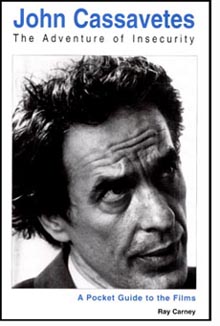 |
-
New
essays on all of the major films, including Shadows,
Faces, Husbands, Minnie and Moskowitz,
A Woman Under the Influence, The Killing of a Chinese
Bookie, Opening Night, and Love Streams
-
New,
previously unknown information about Cassavetes' life and working
methods
-
A
new, previously unpublished interview with Ray Carney about
Cassavetes the person
-
Statements
about life and art by Cassavetes
-
Handsomely
illustrated with more than two dozen behind-the-scenes photographs
Click
here to access a detailed description of the book.
|
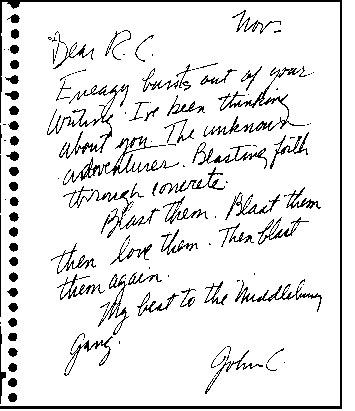 This book is available through
Amazon,
Barnes
and Noble, your local bookseller, or, for a limited time, directly
from the author (in discounted, specially autographed editions).
See below for information how
to order this book directly from the author by money order, check, or
credit card. This book is available through
Amazon,
Barnes
and Noble, your local bookseller, or, for a limited time, directly
from the author (in discounted, specially autographed editions).
See below for information how
to order this book directly from the author by money order, check, or
credit card.
Clicking on the above links
will open a new window in your browser. You may return to this page by
closing that window or by clicking on the window for this page again.
* * *
In addition,
two packets of Ray Carney's writing on John Cassavetes (material
not included
in any of the above books) are also specially available through this
web site. These packets contain the texts of many of his notes and
essays
about the filmmaker. Each packet is available for $15.00.
Collected
Essays on the Life and Work of John Cassavetes (a packet of essays
by Ray Carney previously published in magazines, newspapers, and periodicals
and now unavailable). Approximately 130 pages.
A loose-leaf
bound packet of Ray Carney's writings on John Cassavetes is specially
available only through this web site. The packet has the complete texts
of program notes and essays about Cassavetes that were published by
Ray Carney in a variety of film journals and general interest periodicals
between 1989 and the present. It contains more than fifteen separate
pieces – including the keynote essay commissioned by the Sundance
Film Festival for their retrospective of Cassavetes' work at the time
of his death as well as the memorial piece on Cassavetes awarded a
prize by The Kenyon Review as "one of the best essays of the
year by a younger author."
This packet also
contains the text Ray Carney contributed to the "Special John
Cassavetes Issue" of PostScript edited by Ray Carney,
including "A Polemical Introduction: The Road Not Taken," "Seven
Program Notes from the American Tour of the Complete Films: Faces, Minnie
and Moskowitz, Woman Under the Influence, The Killing
of a Chinese Bookie, and Love Streams." The Collected
Essays on the Life and Work of John Cassavetes is not for
sale in any store, and available exclusively on this web site for $15.00
under the same credit payment terms or at the same mailing address
as the other offers. 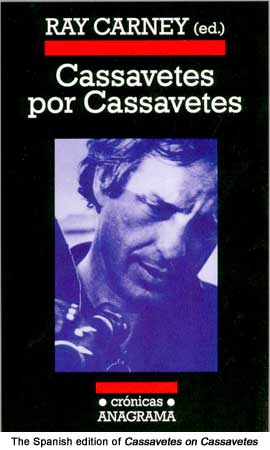
***
"Special
Issue: John Cassavetes." PostScript: Essays in Film and
the Humanities Vol. 11 Number 2 (Winter 1992). Guest editor:
Ray Carney $10.
Handsomely illustrated.
113 double-column pages (50,000 words).
A memorial tribute
to the life and work of John Cassavetes. Essays by Ray Carney, George
Kouvaros, Janice Zwierzynski, and Carole Zucker. Interviews with Al
Ruban and Seymour Cassel by Maria Viera. A history of the critical
appreciation of Cassavetes' work and a bibliography of writing in English
by Lucio Benedetto. The issue is illustrated with more than 40 behind-the-scenes
photos of Cassavetes and his actors and contains many personal statements
by him about his life and work.
This issue includes
eight essays by Ray Carney about Cassavetes' life and work: "A
Polemical Introduction: The Road Not Taken," and "Seven Program
Notes from the American Tour of the Complete Films, about Faces, Minnie
and Moskowitz, Woman Under the Influence, The Killing
of a Chinese Bookie, and Love Streams." But note
that Ray Carney's contributions to the special Cassavetes issue of PostScript magazine
are also available as part of the packet, The Collected Essays
on the Life and Work of John Cassavetes, which contains many other
pieces by Prof. Carney as well. The Collected Essays packet is listed separately above at a price of $15. But if you would like a Xerox copy
of the entire PostScript magazine issue (which includes the
other additional material by the other authors listed above), the PostScript issue
is available separately for $10. You may order it with a credit card
through PayPal or through the mail with a money order. See the instructions
below.
***
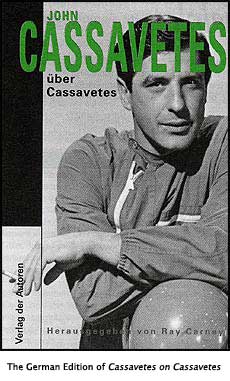 In addition,
a packet comparing the two versions of Shadows is available: A
Detective Story – Going Inside the Heart and Mind of the Artist:
A Study of Cassavetes' Revisionary Process in the Two Versions of
Shadows.
Available direct from the author through this site for $15. In addition,
a packet comparing the two versions of Shadows is available: A
Detective Story – Going Inside the Heart and Mind of the Artist:
A Study of Cassavetes' Revisionary Process in the Two Versions of
Shadows.
Available direct from the author through this site for $15.
This packet contains the following
material (most of which was not included in the BFI Shadows book):
- An introductory essay about
the two versions of the film
- A table noting the minute-by-minute,
shot-by-shot differences in the two prints. (In the British Film Institute
book on Shadows, this table appears in a highly abridged, edited
version, at less than half the length and detail presented here.)
- A conjectural reconstruction
of the shot sequence in the 1957 print
- A shot list for the 1959
re-shoot of the film
- The credits exactly as presented
in the film (including typographical and orthographical vagaries indicating
Cassavetes' view of the importance of various contributors)
- An expanded and corrected
credit listing that includes previous uncredited actors and appearances
(e.g. Cassavetes in a dancing sequence; Gena Rowlands in a chorus
girl sequence; and Danny Simon and Gene Shepherd in the nightclub
sequence)
- Notes about the running
times of both versions and information about dates and places of early
screenings
- A bibliography of suggested
additional reading (including a note about serious mistakes in previous
treatments of the film by other authors)
Very little
of this material was included in the BFI book on Shadows due
to limitations on space. This 85-page (25,000 word) packet is not for
sale in any store
and is available exclusively through this site for $15.
* * *
The five books, two packets,
and issue of PostScript magazine may be obtained directly from the author, by using the Pay Pal
Credit Card button below, or by sending a check or money order to the
address below. However you order the book or books, please provide the
following information:
- Your name and address
- The title of the book you
are ordering
- Whether you would like an
inscription or autograph on the inside front cover
Checks or money orders may
be mailed to:
Ray Carney
Special Book Offer
College of Communication
640 Commonwealth Avenue
Boston University
Boston, MA 02215
|

|
Credit
Card
|
| NEW! |
| Now
you can buy Ray Carney's works online using Visa or MasterCard. |
|
Note:
If you pay by credit card using the PayPal button, please note in
the item description or comments section of the order form the exact
title of the item or items you are ordering (be specific, since
many items have similar titles), as well as any preferences you
may have about an autograph or inscription and the name or nickname
you would like to have on the inscription.
If you are confused
by the PayPal form, or unsure where to enter this information, you
may simply make your credit card payment that way, and separately
email me (at the address below) any and all information about what
item you are ordering, and what inscription or name you would like
me to write on it, or any other details about your purchase. I will
respond promptly.
The PayPal form has
a place for you to indicate the number of items you want (if you
want more than one of any item), as well as your mailing address.
If you place your order
and send your payment by mail, please include a sheet of paper with
the same information on it. I am glad to do custom inscriptions
to friends or relatives, as long as you provide all necessary information,
either on the PayPal form, in a separate email to me, or by regular
mail. (Though I cannot take credit card information by mail; PayPal
is the only way I can do that.)
If you want to order
other items from other pages, and are using the PayPal button, you
may combine several items in one order and have your total payment
reflect the total amount, or you may order other items separately
when you visit other pages. Since there is no added shipping or
handling charge (shipping in the US is free), you will not be penalized
for ordering individual items separately in separate orders. It
will cost exactly the same either way.
These instructions apply
to American shipments only. Individuals from outside the United
States should email me and inquire about pricing and shipping costs
for international shipments.
Clicking on PayPal opens
a separate window in your browser so that this window and the information
in it will always be available for you to consult before, during,
and after clicking on the PayPal button. After you have completed
your PayPal purchase and your order has been placed, you will automatically
be returned to this page. If, on the other hand, you go to the PayPal
page and decide not to complete your order, you may simply close
the PayPal window at any point and this page should still be visible
in a window underneath it.
If you have questions,
comments, or problems, or if you would like to send me additional
information about your order, please feel free to email me
at: raycarney@usa.net.
(Note: Due to the extremely high volume of my email correspondence,
thousands of emails a week, and the diabolical ingenuity of
Spammers, be sure to use a distinctive subject heading in
anything you send me. Do NOT make your subject line read "hi"
or "thanks" or "for your information"
or anything else that might appear to be Spam or your message
will never reach me. Use the name of a filmmaker or the name
of a familiar film or something equally distinctive as your
subject line. That is the only way I will know that your message
was not automatically generated by a Spam robot.)
Problems? Unable
to access the PayPal site? If you are having difficulty, it
is generally because you are using an outdated or insecure
browser. Click
here for help and information about how to check your
browser's security level or update it if necessary.
|
|









